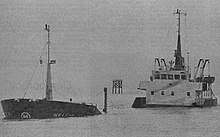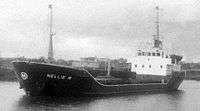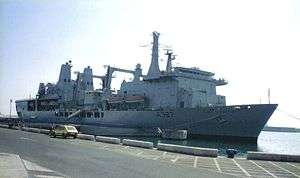Attacks on shipping in Lough Foyle (1981–82)
The Provisional Irish Republican Army (IRA) carried out two bomb attacks against British coal ships in February 1981 and February 1982 at Lough Foyle, a large inlet between County Londonderry in Northern Ireland and County Donegal in the Republic of Ireland. Both vessels were sunk, but their crews reached the coastline safely in lifeboats.
| Attacks on shipping in Lough Foyle | |
|---|---|
| Part of the Troubles | |
 The coaster Nellie M after the bombing | |
| Location | Lough Foyle |
| Date | 6 February 1981 23 February 1982 |
| Target | 2 cargo ships 2,000 BRT |
Attack type | Ship hijacking, bombing |
| Weapons | 2 pilot boats 4 explosive charges |
| Deaths | none |
| Injured | none |
| Perpetrator | Provisional Irish Republican Army |
| Assailants | 24 |
| Motive | To hinder British shipping around Derry |
Early attacks on shipping
There had been a number of attacks on small vessels by the IRA before 1981. On April 1971, a Royal Navy survey launch was blown up at the port of Baltimore, in the Republic of Ireland. The motor boat, the Stork, was towed out to sea and destroyed by an explosive device before dawn, while the crew was ashore.[1] Another British boat, the Puffin, received minor damaged in the same action.[2] Both motor launches were attached to HMS Hecate.[3]
Between February and October 1972 the Provisional IRA carried out two bombings against sand barges at Lough Neagh. Two IRA members were killed by the premature explosion of one of the devices, while two of the barges were sunk in a second incident, with a loss of £80,000.[4][5] These barges were probably the Lough Neagh and the Ballyginniff.[6]
The killing of Lord Mountbatten and three others at Mullaghmore, County Sligo, took place when they were on board Mountbatten's fishing boat, the Shadow V, on 27 August 1979.[7]
Background
The IRA's declared aim was to disrupt the maritime traffic to and from Londonderry Port, on the east bank of the lough. They also intended to force British and Irish authorities to deploy security guards on board merchant ships.[8] The IRA stated that they regarded the ships as "commercial targets".[9]
On the British side, the Bird class patrol boats HMS Cygnet and HMS Kingfisher were already assigned by the Royal Navy to protect the waterways of the province. Their mission was to prevent the smuggling of weapons from the Republic.[10] These warships were often shot at by the IRA, especially from Carlingford Lough.[10] The Cygnet narrowly avoided two .50 rounds fired by a sniper in South Armagh.[11]
Sinking of Nellie M

Nellie M was a coaster ship of 782 BRT, launched in 1972 at Yorkshire. She was owned by S. William Coe & Co. Ltd. of Liverpool at the time of the attack, which took place on 6 February 1981. The vessel was at anchor barely 300 yards (270 m) from the Republic’s shore, awaiting for proceeding up the river. The coal ship had departed from Liverpool with a cargo valued at £1 million.[12]
A team of 12 IRA men, meanwhile, had hijacked a pilot boat at a pier on Moville, on the northwest bank of the inlet. Five of the group remained watching on shore, while another seven members of the ASU, carrying two high explosive charges, forced the skipper to take them to the British coal ship. Once on board, the cell informed her captain about their intentions and ordered him to gather the crew and to get his men into the lifeboat. Four IRA members supervised the evacuation. At the same time, three others planted the charges in the engine room. The hijacked motor launch then took in tow the lifeboat, leaving her adrift close to the eastern shore, and headed back for Moville. As the lifeboat reached the beach, the first explosion shook Nellie M. Huge flames, visible from several miles away, engulfed her bridge. A second blast, some hours later, blew up the bulkheads and the ship began to sink. The morning after, her stern was submerged. The hull was raised in 1982.[13]
Sinking of St. Bedan
The next year, the IRA was able to repeat the same operation against another British coal ship, St. Bedan, bound from Glasgow to Derry. The 1,250 BRT Bedan, built in Clyde and also launched in 1972, was owned by J & A Gardner & Co. Ltd. of Glasgow.[14] On 23 February 1982, the ship was at anchor off Derry, awaiting the tide to proceed upstream.[15]
This time the IRA boarding party was composed of 12 volunteers. The attack was again launched from the pilot boat based at Moville, and after the explosions, the cargo vessel sank on her starboard side in some 15 metres (49 ft) of water.[16] She was raised and scrapped by November 1982.[14] The lifeboat with the crewmembers was towed to the shoreline in the same way as in the case of Nellie M.[15]
Aftermath

One of the unexpected consequences triggered by the bombings was the debate in the Oireachtas about the dispute with the United Kingdom on the legal jurisdiction over the waterways in Northern Ireland. The salvage of Nellie M was conducted by a company from the Republic, and her wreckage was sold to a ship owner in that state, who refurbished the ship under the name of Ellie. The coal ship was subsequently bought by several companies. She was lengthened by 7 metres (23 ft) and renamed Trimix . Since 2000 she is managed by a Colombian company after being rechristened Dove.[12] St. Bedan was instead declared a constructive total loss and scrapped at Liverpool.[14]
The Royal Navy and the Royal Air Force increased their patrols in Northern Ireland waters following the attacks.[17]
A bigger naval target was hit by the IRA several years later, in 1990, when an unknown number of its members managed to board RFA Fort Victoria at anchor near Belfast, shortly after her launching. They planted two large bombs in her engine room. One of the devices exploded, damaging her considerably; the second one was successfully defused.[18]
Lough Foyle was once again the scenario of a Provisional IRA waterborne attack on 23 May 1994, when an active service unit stole a motor boat from Foyle Search and Rescue Service to plant an explosive device at the jetty of Fort George British Army base in Derry. Two soldiers were wounded, and one of them was permanently blinded by the blast.[19]
References
- The Sydney Morning Herald - 22 Abr 1971
- "Royal Navy (Hydrographic Survey Launches) (Hansard, 28 April 1971)". api.parliament.uk. Retrieved 6 March 2020.
- "Republic of Ireland (R.N. Port Survey) (Hansard, 26 April 1971)". api.parliament.uk. Retrieved 6 March 2020.
- Ardoyne Commemoration Project: Ardoyne: the untold truth. Beyond the Pale, 2002, page 104. ISBN 1-900960-17-6
- Deutsch, Richard and Magowan, Vivian: Northern Ireland, 1968-73: 1968-74, a Chronology of Events. Blackstaff Press, 1973, page 231
- Heritage Boat Association: Lough Neagh - Sand Barges - Various
- IRA bombs kill Mountbatten and 17 soldiers The Guardian, 28 August 1979
- Random Ramblings from a Republican
- IRA warns British ships Associated Press, 9 February 1981
- Ripley and Chappel, pg. 30
- Harnden, pg. 400
- Nellie M history and profile
- Saiorse 32, 06/02/2006 From the Derry Journal, 3 February 2011
- St. Bedan history and profile
- The Montreal Gazette, 24 February 1982 From Associated Press
- I.R.A. Guerrillas Destroy A British Cargo Ship, New York times, 24 February 1982
- Navy To Step Up Patrols After IRA Sinks Coaster by David Steele. The Glasgow Herald, 24 February 1982
- Interview to shipbuilder Sir John Parker published by Sunday Times, 13 March 2006
- "Derry man handed 10-year jail sentence for IRA terrorist offences - BelfastTelegraph.co.uk". BelfastTelegraph.co.uk. Retrieved 15 August 2017.
Further reading
- Ripley, Tim and Chappel, Mike: Security forces in Northern Ireland (1969-92). Osprey, 1993. ISBN 0-340-71737-8
- Harnden, Toby: Bandit Country:The IRA and South Armagh. Coronet Books, 1999. ISBN 1-85532-278-1
- Nellie M history and profile
- St Bedan history and profile
- Oireachtas debate, 31 March 1981